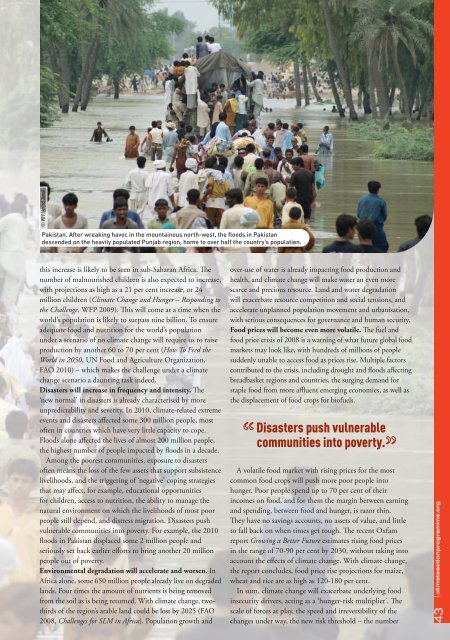Climate Action 2011-2012
You also want an ePaper? Increase the reach of your titles
YUMPU automatically turns print PDFs into web optimized ePapers that Google loves.
© WFP/Amjad Jamal<br />
Pakistan. After wreaking havoc in the mountainous north-west, the floods in Pakistan<br />
descended on the heavily populated Punjab region, home to over half the country’s population.<br />
this increase is likely to be seen in sub-Saharan Africa. The<br />
number of malnourished children is also expected to increase,<br />
with projections as high as a 21 per cent increase, or 24<br />
million children (<strong>Climate</strong> Change and Hunger – Responding to<br />
the Challenge, WFP 2009). This will come at a time when the<br />
world’s population is likely to surpass nine billion. To ensure<br />
adequate food and nutrition for the world’s population<br />
under a scenario of no climate change will require us to raise<br />
production by another 60 to 70 per cent (How To Feed the<br />
World in 2050, UN Food and Agriculture Organization,<br />
FAO 2010) – which makes the challenge under a climate<br />
change scenario a daunting task indeed.<br />
Disasters will increase in frequency and intensity. The<br />
‘new normal’ in disasters is already characterised by more<br />
unpredictability and severity. In 2010, climate-related extreme<br />
events and disasters affected some 300 million people, most<br />
often in countries which have very little capacity to cope.<br />
Floods alone affected the lives of almost 200 million people,<br />
the highest number of people impacted by floods in a decade.<br />
Among the poorest communities, exposure to disasters<br />
often means the loss of the few assets that support subsistence<br />
livelihoods, and the triggering of ‘negative’ coping strategies<br />
that may affect, for example, educational opportunities<br />
for children, access to nutrition, the ability to manage the<br />
natural environment on which the livelihoods of most poor<br />
people still depend, and distress migration. Disasters push<br />
vulnerable communities into poverty. For example, the 2010<br />
floods in Pakistan displaced some 2 million people and<br />
seriously set back earlier efforts to bring another 20 million<br />
people out of poverty.<br />
Environmental degradation will accelerate and worsen. In<br />
Africa alone, some 650 million people already live on degraded<br />
lands. Four times the amount of nutrients is being removed<br />
from the soil as is being returned. With climate change, twothirds<br />
of the region’s arable land could be lost by 2025 (FAO<br />
2008, Challenges for SLM in Africa). Population growth and<br />
over-use of water is already impacting food production and<br />
health, and climate change will make water an even more<br />
scarce and precious resource. Land and water degradation<br />
will exacerbate resource competition and social tensions, and<br />
accelerate unplanned population movement and urbanisation,<br />
with serious consequences for governance and human security.<br />
Food prices will become even more volatile. The fuel and<br />
food price crisis of 2008 is a warning of what future global food<br />
markets may look like, with hundreds of millions of people<br />
suddenly unable to access food as prices rise. Multiple factors<br />
contributed to the crisis, including drought and floods affecting<br />
breadbasket regions and countries, the surging demand for<br />
staple food from more affluent emerging economies, as well as<br />
the displacement of food crops for biofuels.<br />
Disasters push vulnerable<br />
communities into poverty.<br />
A volatile food market with rising prices for the most<br />
common food crops will push more poor people into<br />
hunger. Poor people spend up to 70 per cent of their<br />
incomes on food, and for them the margin between earning<br />
and spending, between food and hunger, is razor thin.<br />
They have no savings accounts, no assets of value, and little<br />
to fall back on when times get tough. The recent Oxfam<br />
report Growing a Better Future estimates rising food prices<br />
in the range of 70-90 per cent by 2030, without taking into<br />
account the effects of climate change. With climate change,<br />
the report concludes, food price rise projections for maize,<br />
wheat and rice are as high as 120-180 per cent.<br />
In sum, climate change will exacerbate underlying food<br />
insecurity drivers, acting as a ‘hunger-risk multiplier’. The<br />
scale of forces at play, the speed and irreversibility of the<br />
changes under way, the new risk threshold – the number<br />
43 climateactionprogramme.org












